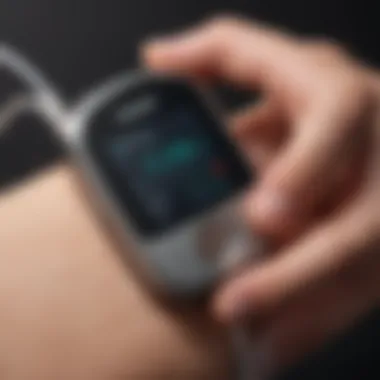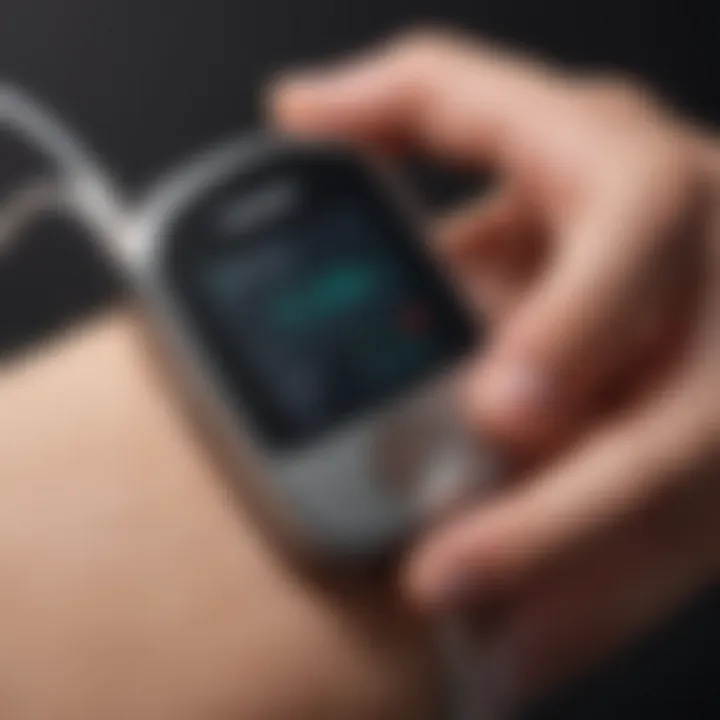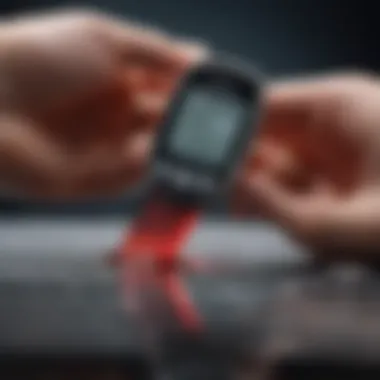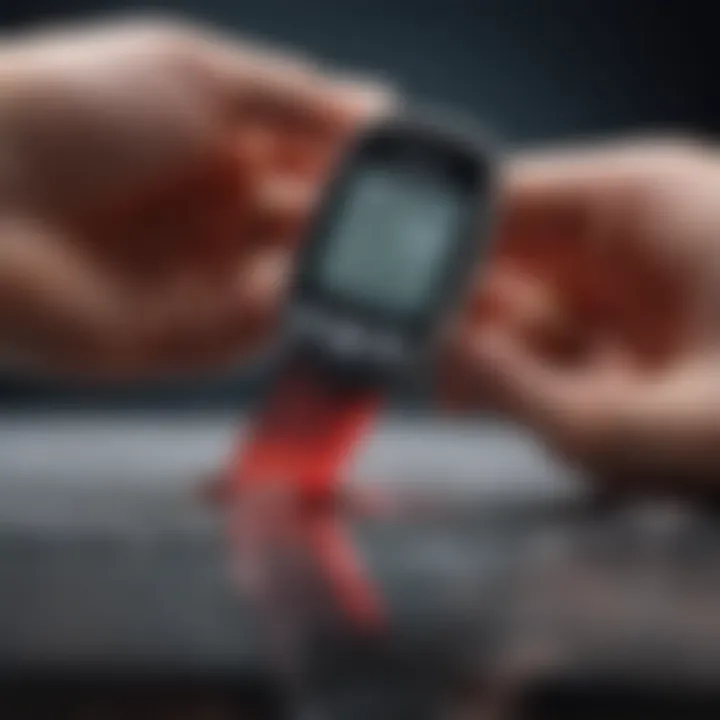Exploring Non-Prick Blood Sugar Testing Methods Today


Intro
The realm of diabetes management is continuously evolving, particularly with the advent of non-prick blood sugar testing methods. The discomfort and inconvenience associated with traditional techniques, like finger pricking, have prompted advancements in technology. This guide seeks to explore how non-invasive testing has transformed the ways individuals monitor their blood sugar levels.
Comprehending these methods and their implications is crucial as they hold significant potential for improving diabetes care. From understanding different testing devices to navigating their efficiencies, becomes imperative for positive patient experiences. The intersection of technology and healthcare paints an intriguing picture that merits thorough exploration.
Product Overview
In the context of non-prick testing, several products exemplify innovation in diabetes management. One prominent example is the continuous glucose monitor, a device that continuously tracks glucose levels in real-time without painful and frequent skin punctures.
These monitors utilize various technologies, such as electrochemical sensors and radio signals, enabling individuals to gain immediate insight into their glucose levels. This is not only a remarkable advancement for patients but also significantly contributes to more informed healthcare decisions. Some key features often include:
- Real-time monitoring: Continuous data on glucose levels.
- Alert systems: Notifications for glucose levels that are too high or too low.
- Bluetooth connectivity: Ability to sync data to mobile devices for easier visualization and tracking.
Ensuring these devices are user-friendly is a critical consideration in their design. Ergonomic layouts paired with intuitive interfaces can vastly enhance the user experience, which is a crucial element in healthcare technology.
Performance and User Experience
Evaluating the performance of non-prick testing devices is essential. Each product comes with unique benchmarks to assess efficacy, including:
- Accuracy Ratings: Measurement of glucose levels as compared to laboratory tests.
- Battery Life: How long the device continues to function.
In terms of user interface, modern designs aim for accessibility. Software capabilities provide features such as:
- Data visualization and trends over time.
- Integrative apps for monitoring and sharing with healthcare professionals.
Users often share richly varied experiences with these devices. Many appreciate the avoidance of traditional blood tests, pointing to reduced physical discomfort. However, notable frustrations often revolve around connectivity issues or calibration errors. Collectively, such feedback can drive further enhancements in future models.
Comparison with Previous Models or Competitors
Assessing how current devices improve upon earlier models is vital for understanding their value. Advances such as enhanced sensors and increased frequency of readings provide greater accuracy. Moreover, novel competitors emerge consistently in this market, making continuous analysis prudent. Key focus areas include:
- Functionality: New models often blend multiple features into one device.
- Cost-Efficiency: Many around, weighing the cost-to-benefit ratio of proposed devices.
- User Support: Contrast arises in support quality from multiple manufacturers.
Tips and Tricks
Maximizing the usefulness of non-prick testing devices entails understanding how to use them to their full potential. For newcomers to the technology, consider reviewing:
- User manuals for features unique to your specific device.
- Online communities where real-world tips can be learned.
- Understanding how to adjust settings according to lifestyle needs based on activity levels.
Technical glitches can sometimes arise. Troubleshooting barriers can often streamline your process towards manageable diabetes care.
Latest Updates and News
Staying informed about recent developments in non-prick blood sugar tests is essential. The landscape evolves with updates and enhancements across varied models. Information may include:
- Software improvements enhancing functionality.
- Significant events or announcements such as industry conferences showcasing innovations.
Keep an eye on platforms like Wikipedia for foundational knowledge and the latest news on diabetes technology innovations. Additionally, sites like reddit.com can serve as useful spaces to engage directly with user experiences and perspectives on up-to-date technology reflections.
Prelude to Non-Prick Blood Sugar Tests
In recent years, blood sugar management has made significant strides, especially with advances in non-prick testing methods. These innovations have fundamentally reshaped how individuals manage diabetes. This section introduces several key concepts that underlie non-prick blood sugar testing. An understanding of these concepts is essential for both patients and healthcare professionals.
Definition and Overview
Non-prick blood sugar tests refer to methods that do not require the traditional finger-prick to obtain a blood sample. Many of these tests employ various technologies to estimate blood glucose levels through alternative approaches. This industry has expanded rapidly due to its capacity to make testing fairly painless, thereby increasing access for users. Such technology may include continuous glucose monitoring systems, non-invasive sensors, and smart device integrations.
Patients diagnosed with diabetes and those caring for them greatly benefit from non-prick testing. Instead of frequent fingerstick procedures, patients can use a range of devices that measure glucose through the skin or other less invasive means. Innovations like these yield not only data but also empowerment and convenience, vital for maintaining compliance with diabetes management protocols.
Importance in Diabetes Care


The significance of non-prick blood sugar tests extends beyond mere ease of use. They play a crucial role in enhancing overall diabetes care. With these devices, patients acquire timely and accurate data, which empowers better decision-making in their daily routines. Regular monitoring becomes simpler, encouraging individuals to remain proactive, thus optimally controlling their blood sugar.
Moreover, the limitations of traditional methods are noteworthy. Finger-prick testing can discourage patient engagement due to discomfort and the chance of infection from repeated punctures. By contrast, non-prick methods mitigate these issues, fostering a supportive environment where diabetic individuals can closely monitor their health.
Benefits of incorporating non-prick blood sugar tests into daily management include:
- Enhanced Comfort: Less pain leads to improved user experiences.
- Simplified Monitoring: Frequent checks become less of a hassle.
- Increased Compliance: Patients more likely to adhere to testing regimes.
In summary, non-prick blood sugar tests are valuable tools in diabetes management. They shift the conversation from invasive techniques toward user-friendly options. As technology evolves, the effectiveness of non-prick testing will only grow, proving vital in managing and living with diabetes.
Historical Context of Blood Sugar Testing
Understanding the historical context of blood sugar testing provides vital insights into the development of non-prick blood sugar tests. Digging into the past reveals how technological advancements have transformed diabetes care. With each successive innovation, there has been a clear shift towards more complex, yet user-friendly systems, which has shaped how both medical professionals and patients approach blood sugar monitoring. The evolution highlights not just technological benefits but also sheds light on user experiences, accuracy, and health outcomes.
Evolution of Testing Techniques
In the early stages, diabetes management heavily relied on simple tests that involved laboratory analysis and qualitative methods. Techniques like urine glucose testing offered minimal insights and patient compliance considerably dropped due to inconvenience. Furthermore, accuracy often varied due to variables like hydration levels and food intake.
Over time, technicians created more precise methods for direct measurement of blood glucose levels. Fingerstick tests emerged, marking a significant shift thanks to their ability to offer real-time feedback. The development of these glucometers led to a gradual increase in accuracy and immediate results.
Yet the discomfort associated with needle pricks posed limitations for many users.
“The evolving technology has not only focused on accuracy, but there is an increasing value placed on comfort and user experience.”
Shift from Invasive to Non-Invasive Methods
The inconvenient nature of fingerstick tests triggered innovation in the market. There started a clear demand for less invasive options due to a preference for comfort and convenience. Manufacturing companies aimed to address concerns about pain associated with traditional methods. The rise of non-invasive testing methods was a direct response to that demand.
Recent advancements, such as continuous glucose monitoring systems, facilitate real-time tracking without requiring regular piercings into the skin, marking a distinct break from the past. For instance, devices that use light or electromagnetic signals to assess glucose levels offer potential benefits, operating through hypothetic tissue-like modeling.
The result of this transition has led to improved diabetes management through easier access to data, ultimately translating to better health results. Non-prick testing represents a significant stride in where medical technology is taking diabetes care and how patients interact with that technology.*
Technologies Behind Non-Prick Testing
The landscape of blood sugar testing has changed significantly over the past few years. Technologies have been developed that eliminate the discomfort and inconvenience associated with traditional methods. These advancements are crucial for patients and healthcare professionals alike. Understanding these technologies can aid individuals in managing diabetes more effectively.
Continuous Glucose Monitoring Systems
Continuous Glucose Monitoring (CGM) systems are at the forefront of non-prick testing technology. These devices offer real-time glucose level monitoring throughout the day and night. A small sensor is placed under the skin, often on the abdomen or arm, measuring glucose levels in the interstitial fluid. This sensor transmits data to a nearby display device or smartphone app.
Users benefit from alerts when glucose levels go too high or dangerously low. This real-time data is invaluable for making timely decisions regarding diet and lifestyle. Features of CGM include:
- Automatic updates of glucose readings every few minutes
- Data logging to help identify trends over time
- Shared access for caregivers or family members
Despite their advantages, CGMs have some challenges. These include cost, the need for occasional sensor calibration, and potential comfort issues upon implantation. Overall, they provide a comprehensive look at glucose trends, positioning themselves as essential tools in diabetes management.
Non-Invasive Glucose Sensors
Non-invasive glucose sensors represent another technological innovation. These devices aim to measure blood sugar levels without penetrating the skin. Various mechanisms are employed. For example, some use light sensors that analyze glucose levels based on how much light reflects off the skin’s surface. Others utilize electromagnetic waves.
Advantages of non-invasive devices include:
- Greater comfort, as they do not require skin penetration
- The potential for more consistent monitoring without pain
- Encouragement for regular checks, improving overall health outcomes
However, non-invasive methods may face challenges regarding their accuracy compared to traditional methods. This type of technology is still evolving, and while promising, it requires further validation through clinical studies to ensure reliability and efficiency.
Other Emerging Technologies
Various novel technologies are on the horizon for non-prick blood sugar monitoring. Some worth mentioning include:
- Smart Wearables: Devices being developed to integrate glucose monitoring into wearables, such as smartwatches, could signal a significant breakthrough. These can track activity while simultaneously keeping an eye on blood sugar levels.
- Breathalyzers for Glucose: Research is underway on devices that can assess glucose through breath analysis. This method could simplify monitoring further and could potentially be a game-changer.
- Smart Contact Lenses: While in the development stage, smart contact lenses that test glucose levels through tears could one day convert daily checks into processes requiring little effort.
The integration of technology in blood sugar management not only enhances ease of monitoring but also potentially transforms lifestyle for those managing diabetes. Many of these advancements offer robust solutions aimed at making life easier and more manageable for patients, and their future can have significant implications on global health.


The continuous development in non-prick blood sugar testing technologies is assisting better management for people living with diabetes.
In summary, there's immense potential in the technologies shaping non-prick blood glucose testing. They not only promise comfort and convenience but also have the capability to reshape diabetes management fundamentally.
Advantages of Non-Prick Testing
Non-prick blood sugar testing presents numerous advantages that cater to the needs of both patients and healthcare providers. As these technologies continue to evolve and find their place in diabetes management, understanding their benefits is crucial. This section will explore the key advantages: comfort and convenience, reduction in infection risks, and improved patient compliance. Each aspect provides significant weight to the arguments for wider adoption and trust in non-invasive methods.
Comfort and Convenience
With non-prick testing, as its name implies, the discomfort associated with needle sticks is eliminated. Patients can monitor their glucose levels without the repeated pricks that conventional methods necessitate. This real benefit translates into an easier daily routine for individuals managing diabetes. Consider the stress and anxiety that frequent finger pricks can invoke; non-prick technologies alleviate these concerns entirely.
By utilizing devices such as continuous glucose monitors, the burden of frequent testing is reduced considerably. Often, these devices can be worn comfortably and provide continuous data about blood sugar levels throughout the day, gaining insights without disrupting one's lifestyle. In essence, the consumer-friendly aspect encourages users to adopt their monitoring with less hesitation, fostering a proactive approach to diabetes management.
Reduction in Infection Risks
Invasive methods for blood sugar testing carry inherent risks of infection. Each fingerstick opens a minute wound, which could lead to complications if not managed properly. Non-prick methods vastly reduce this risk by eliminating skin penetration. Instead of pricking the skin, many devices analyze variations in body fluids or employ optical measurements.
While some may underestimate this aspect, the prevention of infection can have immediate and long-term benefits. Patients using non-invasive testing are significantly less likely to deal with issues like those seen in traditional methods, remaining healthier overall. Not only is this a comfort advantage, backed by sound medical practice, it also serves the practical concern of reducing the burden on healthcare systems from avoidable infections or complications.
Improved Patient Compliance
Another compelling advantage of non-prick testing is the likely increase in patient compliance. Studies indicate that adherence to personalized diabetes management plans improves when patients experience less discomfort and inconvenience. Specifically, the world of non-prick technology often sees patients willing to check their blood sugar levels more frequently and consistently.
Compliance advantages impact overall health outcomes. Higher rates of testing facilitate better management of blood glucose levels, allowing for adjustments to medications and lifestyle choices as needed. This relationship highlights the significant potential of non-prick blood sugar testing in advancing diabetic care and improving the quality of life for individuals utilizing these systems.
By removing the psychological barriers associated with invasive testing, non-prick methods enhance patient involvement in their health management.
Limitations and Challenges
The advent of non-prick blood sugar testing methods marks a significant shift in diabetes management. However, it is vital to critically analyze the limitations and challenges associated with these technologies. Understanding these aspects is crucial for informed decision-making regarding options available to patients.
Accuracy of Non-Prick Tests
Accuracy remains a primary concern for users considering non-prick blood sugar testing methods. Current technologies, while innovative, often face scrutiny regarding their reliability especially in cmpairson to traditional methods. Research shows that certain continuous glucose monitors, such as the Freestyle Libre and Dexcom G6, can misrepresent blood glucose levels, particularly during rapidly changing glucose readings. For individuals with tight glucose control needs, inaccuracies could result in improper management and safety concerns.
Despite advancements, a consensus on the exact levels of accuracy with various devices is still developing. Potential buyers should look at recent studies and user feedback before making a decision based solely on convenience over precision.
Cost Considerations
Cost is an essential factor that influences the adoption of non-prick blood sugar testing methods. While some devices offer advantages like reducing the pain associated with fingersticks, their price points can be steeper than traditional testing. For instance, devices from manufacturers like Abbott and Dexcom may entail an initial investment that is higher than conventional glucometers, along with ongoing costs for sensors if using continuous glucose monitoring.
Patients without insurance support for such technologies might face a significant financial burden. Maintaining quality in diabetes care should often take precedence; thus it could be advisable to navigate through insurance options or explore locational programs/subsidies that help mitigate these expenses.
User Limitations
User testimonials reflect a range of experiences when transitioning to non-prick blood sugar tests. While many praise the simplified user experience, some individuals might struggle to adapt. Especially for older adults or those less inclined toward tech, interfacing with devices can induce frustration. Simply put, not everyone possesses the required technological aptitude. Additional training may become necessary, thus further lengthening the adoption curve.
Moreover, the amount of real-time data collected may overwhelm certain users. Behavioral health factors, such as resistance to change or anxiety over handling new devices, can impede consistency in testing. Encouraging education through healthcare providers is essential. Equipping users with support systems will help overcome hesitation in utilizing these novel methods in their daily monitoring regimens.
Understanding the limitations and challenges of non-prick blood sugar tests is essential, promoting better decisions among users and providers alike.
As with any medical technology, a balanced perspective is needed. Just as the emergence of non-invasive techniques offer utmost convenience, understanding their soft points and the varying realities among users ensures that every patient can select the most suitable diabetes management tool tailored for them.
Comparison with Traditional Methods
The comparison between non-prick blood sugar tests and traditional methods, such as fingerstick glucose testing, serves as an essential part of understanding how advancements in technology can transform diabetes care. Non-prick tests promise multiple benefits alongside considerations that practitioners and patients must contemplate.
Fingerstick Glucose Testing
Fingerstick glucose testing has long been the conventional method for blood glucose sampling. One of its main differentiating factors is its established track record. The device—a simple lancing device—can extract a small droplet of blood from the fingertip, providing immediate glucose readings. This method, however, has inherent disadvantages:
- Discomfort: Many people find fingersticks painful, which can deter regular testing.
- Infection Risk: Repeatedly puncturing the skin can open the door to potential infections.
- Hassle and Time: The preparation and blood collection process can slow down the testing experience.
Despite these drawbacks, fingerstick glucose testing has remained widely adopted due to its reliability. The results are accurate and can provide real-time feedback, important when making immediate decisions concerning food or insulin intake.


Comparative Analysis of Accuracy
Accuracy remains a prime consideration when evaluating non-prick methods against traditional techniques. While the technology in non-prick testing continues to improve, it is important to not overlook the established precision of fingerstick tests.
- Non-Prick Tests: Non-prick blood sugar testing often incorporates various forms of sensor technology. In some studies, the data from these devices are comparable to what is typically obtained through fingerstick testing. Many users appreciate that non-prick tests provide measurements without pain.
- Considerations for Clinicians: Professionals must weigh reliability with user adherence. A device that encourages more frequent testing might mitigate fluctuations in glucose levels. For example, continuous glucose monitoring systems often show trends over time which can be more insightful than individual fingerstick tests.
"The potential for non-intrusive techniques impacts how often patients test their glucose and track their diet and medication management."
As technology continues to evolve, both accuracy and adherence will shape the future of blood sugar test methods. Ensuring equal accessibility to non-and minimal invasive devices will foster better diabetes management and offer patients more control over their health.
Current Market Landscape
The landscape of non-prick blood sugar testing is marked by continual innovation and evolving consumer needs. This section examines leading devices and manufacturers alongside key market trends that inform these changes. Understanding the market landscape is crucial for users and industry professionals alike. It points to the direction future technologies will likely take and identifies essentials for wise consumer choices.
Leading Devices and Manufacturers
In today's market, various devices have risen to prominence. Some well-known manufacturers in this space include:
- Dexcom: A market leader in continuous glucose monitoring, offering sensors that allow near real-time BG readings.
- Abbott's FreeStyle Libre: Known for its ease of use, this system offers painless continuous glucose monitoring.
- Medtronic: They provide integrated products that combine last-generation technology in non-invasive testing.
These devices have set new standards in user experience and accessibility, allowing individuals to manage diabetes more effectively without frequent finger pricks.
Consumer Feedback and Trends
Consumer feedback in the non-prick testing arena often highlights both satisfaction and areas for improvement. Many users applaud the comfort and convenience brought by devices such as the FreeStyle Libre, stating:
"The ability to check my sugar levels without a prick changed everything for me! It’s a seamless part of my day now."
However, some users express concerns regarding the accuracy, especially in varied conditions of physical activity or hydration levels. Trends show a demand for more refined accuracy in readings and better integration with mobile technology. Consumers increasingly favor products that seamlessly connect with other health apps, simplifying data tracking.
In summary, the current market is dynamic, driven by technological advancements and user feedback. As manufacturers continue to innovate, it becomes imperative for users to stay informed about their choices. This awareness can lead to improved management of diabetes, ultimately enhancing users' quality of life.
Future of Non-Prick Blood Sugar Testing
The field of blood sugar monitoring is witnessing significant transformation, particularly with the advancements in non-prick blood sugar testing. This section will explore the various facets that will shape the future of these technologies, highlighting key innovations and potential implications for diabetes care globally.
Innovative Developments on the Horizon
Technological progress is incessant. In the context of non-prick blood sugar testing, innovations are continuously emerging. One such development is the improvement of continuous glucose monitoring (CGM) devices. These devices have become more sophisticated, offering real-time readings with enhanced accuracy. As sensor technologies evolve, devices like the Freestyle Libre and Dexcom G6 show increasing precision in measuring glucose levels without invasive techniques.
Another significant trend is work on non-invasive methods that utilize advanced biomarkers. Research into glucose-sensing technology through spectroscopy and bioimpedance has shown promising results. These methods are being optimized to provide dependable readings based on body fluids other than blood.
Moreover, developments in machine learning and artificial intelligence are likely to pinpoint patterns in glucose variations, allowing individuals to receive alerts about their blood sugar levels proactively. Integrating smart technology into personal devices benefits user experience and enhances data interpretation in diabetes management.
Potential Impact on Global Diabetes Management
The benefits of non-prick blood sugar tests are immense, especially when aiming at global diabetes management. First, ease of use encourages broader adoption across diverse demographics. Patients who have previously hesitated to conduct regular tests due to pain or discomfort are encouraged to monitor their levels regularly with non-invasive methods.
Additionally, improved management tools available through smart technology increase healthcare access to information. This allows healthcare providers to analyze real-time data effectively. Consequently, personalized treatment plans can emerge based on precise, up-to-date, and accurate glucose monitoring.
Furthermore, integrating non-prick testing into comprehensive health systems allows health bodies to strategize better in fighting diabetes. With enhanced tracking and reporting tools, data accessibility improves population health management strategies, such as identifying trends associated with diabetes and facilitating preventive measures.
In summary, the progression of non-prick blood sugar testing can crucially influence how diabetes care is delivered and experienced worldwide.
Thus, the importance of these developments in the future landscape of diabetes management cannot be overstated. By embracing innovation in monitoring techniques, we pave the way for improved patient outcomes and a greater quality of life for millions managing diabetes.
Finale
The concluding section of this article encapsulates the critical elements surrounding non-prick blood sugar testing. These advances represent a significant paradigm shift in diabetes management. Non-invasive technologies, particularly their comfort and minimization of psychological barriers, enhance patient compliance significantly. Overall, they reduce reliance on traditional methods that might cause discomfort or anxiety. It is crucial not to overlook the diverse user landscape, where individual preferences and medical conditions play vital roles.
Recap of Key Points
- Non-Prick Methods Overview: This guide examined various non-invasive techniques utilized in blood sugar monitoring. Continuous glucose monitoring systems and newer non-invasive glucose sensors were highlighted.
- Advantages: Benefits include comfort, a significant decrease in infection risks, and enhanced compliance among patients. These aspects contribute to better glucose management.
- Limitations: While numerous advantages exist, there are also challenges regarding accuracy and cost considerations that must be addressed. Emerging technologies must overcome these to gain wider adoption.
- Future Perspectives: The horizon looks promising for non-prick blood sugar testing with continual innovations promising improved accuracy and broader acceptance.
Final Thoughts on Non-Prick Testing
Non-prick blood sugar tests mark substantial progress in diabetes care. They facilitate patient autonomy and improve overall health outcomes. Users can expect ongoing research leading to enhancements in methodology, yielding more precise results while maintaining convenience. Keeping abreast of emerging technologies will ensure informed choices for those managing diabetes. The transition to embracing these methods reflects an adaptive market, catering to evolving patient needs and healthcare practices. The promise of pain-free monitoring can not be understated, as this represents a greater movement towards patient-centered care that respects individual experiences and improves health literacy across the board.
Non-invasive strategies symbolize more than mere convenience; they represent empathy in healthcare, considering both physical and emotional patient needs.



